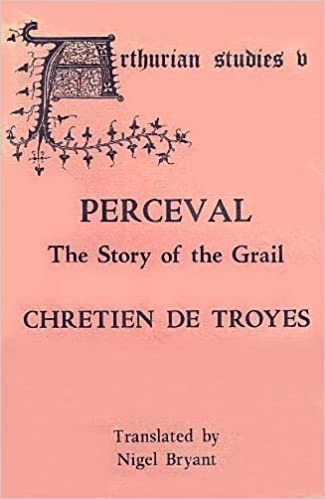Reading Level
What is the reading level of Perceval: The Story of the Grail?
Analysing the books in the series, we estimate that the reading level of Perceval: The Story of the Grail is 7th and 8th grade.
Expert Readability Tests for
Perceval: The Story of the Grail
| Readability Test | Reading Level |
|---|---|
| Flesch Kincaid Scale | Grade 7 |
| SMOG Index | Grade 8 |
| Coleman Liau Index | Grade 7 |
| Dale Chall Readability Score | Grade 6 |
Reading Time
10 hrs 20 mins
How long to read Perceval: The Story of the Grail?
The estimated word count of Perceval: The Story of the Grail is 155,000 words.
A person reading at the average speed of 250 words/min, will finish the book in 10 hrs 20 mins. At a slower speed of 150 words/min, they will finish it in 17 hrs 14 mins. At a faster speed of 450 words/min, they will finish it in 5 hrs 45 mins.
| Perceval: The Story of the Grail - 155,000 words | ||
|---|---|---|
| Reading Speed | Time to Read | |
| Slow | 150 words/min | 17 hrs 14 mins |
| Average | 250 words/min | 10 hrs 20 mins |
| Fast | 450 words/min | 5 hrs 45 mins |
- Authors
-
Chretien de Troyes
More about Perceval: The Story of the Grail
155,000 words
Word Count
for Perceval: The Story of the Grail
260 pages
Pages
16 hours and 40 minutes
Audiobook length
Description
This book is translated from the first volume of “Perceval le Gallois ou le conte du Graal”; edited by M. Ch. Potvin for ‘La Societe des Bibliophiles Belges’ in 1866,1 from the MS. numbered 11,145 in the library of the Dukes of Burgundy at Brussels. This MS. I find thus described in M. F. J. Marchal’s catalogue of that priceless collection: ‘“Le Roman de Saint Graal”, beginning “Ores lestoires”, in the French language; date, first third of the sixteenth century; with ornamental capitals.’2 Written three centuries later than the original romance, and full as it is of faults of the scribe, this manuscript is by far the most complete known copy of the “Book of the Graal” in existence, being defective only in Branch XXI. Titles 8 and 9, the substance of which is fortunately preserved elsewhere. Large fragments, however, amounting in all to nearly one-seventh of the whole, of a copy in handwriting of the thirteenth century, are preserved in six consecutive leaves and one detached leaf bound up with a number of other works in a MS. numbered 113 in the City Library at Berne. The volume is in folio on vellum closely written in three columns to the page, and the seven leaves follow the last poem contained in it, entitled “Duremart le Gallois”. The manuscript is well known, having been lent to M. de Sainte Palaye for use in the Monuments of French History issued by the Benedictines of the Congregation of St Maur. Selections from the poems it contains are given in Sinner’s “Extraits de Poesie du XIII. Siecle”,3 and it is described, unfortunately without any reference to these particular leaves, by the same learned librarian in the “Catalogus Codicum MSS. Bibl. Bernensis”, J.R. Sinner. 4 M. Potvin has carefully collated for his edition all that is preserved of the Romance in this manuscript, comprising all the beginning of the work as far as Branch III. Title 8, about the middle, and from Branch XIX. Title 23, near the beginning, to Branch XXX. Title 5, in the middle. Making allowance for variations of spelling and sundry minor differences of reading, by no means always in favour of the earlier scribe, the Berne fragments are identical with the corresponding portions of the Brussels manuscript, and it is therefore safe to assume that the latter is on the whole an accurate transcript of the entire original Romance. The only note of time in the book itself is contained in the declaration at the end. From this it appears that it was written by order of the Seingnor of Cambrein for Messire Jehan the Seingnor of Neele. M. Potvin, without giving any reason for so doing, assumes that this Lord of Cambrein is none other than the Bishop of Cambrai. If this assumption be correct, the person referred to was probably either John of Berhune, who held the see from 1200 till July 27, 1219, or his successor Godfrey of Fontaines (Conde), who held it till 1237. To me, however, it seems more likely that the personage intended was in reality the ‘Seingnor’ of Cambrin, the chef-lieu of a canton of the same name, on a small hill overlooking the peatmarshes of Bethune, albeit I can find no other record of any such landed proprietor’s existence. Be this as it may, the Messire Jehan, Seingnor of Neele, can hardly be other than the John de Nesle who was present at the battle of Bouvines in 1214, and who in 1225 sold the lordship of Bruges to Joan of Flanders.5 These dates therefore may be regarded as defining that of the original Romance within fairly narrow limits. This conclusion is confirmed by other evidence. An early Welsh translation of the story was published with an English version and a glossary by the Rev. Robert Williams in the first volume of his “Selections from the Hengwrt MSS”.6 The first volume of this work is entitled “Y Seint Greal, being the adventures of King Arthur’s knights of the Round Table, in the quest of the Holy Grail, and on other occasions.
